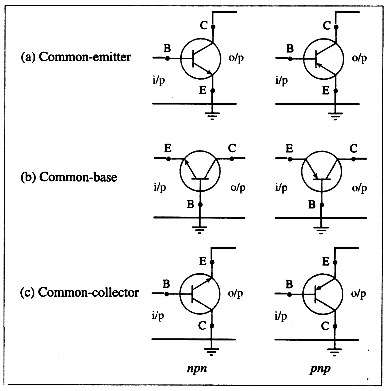There are three configurations in which a transistor may be connected in a circuit:
(a) Common-emitter (CE) : The emitter terminal is common to the input and output circuits.
(b) Common-base (CB) : The base terminal is common to the input and output circuits.
(c) Common-collector (CC) : The collector terminal is common to the input and output circuits.

Transistor configurations
[Notes : (1) CE: Produces the highest current and power gain of all the three bipolar transistor configurations the reason why it is the most commonly used configuration for transistor based amplifiers. The emitter is grounded and the input signal applied between the base and emitter. The input impedance is small due to the forward biasing of the EB-junction. The output taken from between the collector and emitter, as well as the output impedance, are large due to the reverse biased CB-junction. However, its voltage gain is much lower. – (2) CB : The base terminal is grounded, the input signal is applied between the base and emitter terminals while the output signal is taken from between the base and collector terminals. Though its high frequency response is good for single stage amplifier circuits, it is not very common due to its low current gain characteristics and low input impedance. (3) CC : Very useful for impedance matching applications because of the very large ratio of input impedance to output impedance. The collector is grounded and the input signal is directly given to the base. The output is taken across the load resistor in series with the emitter. Hence, the current through the load resistor is the emitter current and the current gain of the configuration is approximately equal to the β value of the transistor.]